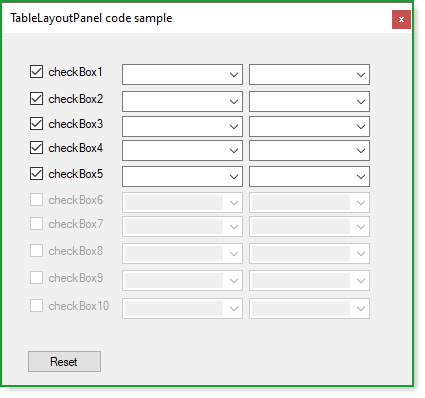
Hello @Art Hansen
The following code sample uses a Tablelayoutpanel (secondary thought was a DataGridView formatted to look the same as the TableLayoutPanel but that takes more code). Each control has it's tag property set, first row the CheckBox and two ComboBox controls tag is 0, moving on to the last row the tag is 9. This should get you going.
Extensions class
using System;
using System.Text.RegularExpressions;
namespace ClearControlsWindowsForms.Extensions
{
public static class ControlHelpers
{
public static int GetInt(this string sender) => Convert.ToInt32(Regex.Match(sender, @"\d+\.*\d*").Value) - 1;
}
}
Form code
using ClearControlsWindowsForms.Extensions;
using System;
using System.Collections.Generic;
using System.ComponentModel;
using System.Data;
using System.Diagnostics;
using System.Drawing;
using System.Linq;
using System.Text;
using System.Threading.Tasks;
using System.Windows.Forms;
namespace ClearControlsWindowsForms
{
public partial class MainForm : Form
{
public MainForm()
{
InitializeComponent();
tableLayoutPanel1.Controls.OfType<CheckBox>().ToList()
.ForEach(cb => cb.CheckStateChanged += OnCheckStateChanged);
}
private void OnCheckStateChanged(object sender, EventArgs e)
{
if (_working)
{
return;
}
var cb = (CheckBox)sender;
if (cb.Checked) return;
var checkBoxIndex = cb.Name.GetInt() ;
var checkBoxes = tableLayoutPanel1.Controls.OfType<CheckBox>().ToList();
foreach (var checkBox in checkBoxes)
{
var cbIndex = checkBox.Name.GetInt();
if (cbIndex <= checkBoxIndex)
{
checkBox.Checked = true;
}
else
{
checkBox.Enabled = false;
var tagIndex = Convert.ToInt32(checkBox.Tag);
var controls = tableLayoutPanel1
.Controls.OfType<ComboBox>()
.Where(c => Convert.ToInt32(c.Tag) == tagIndex);
foreach (var comboBox in controls)
{
comboBox.Enabled = false;
}
}
}
}
private bool _working;
private void ResetButton_Click(object sender, EventArgs e)
{
_working = true;
foreach (var control in tableLayoutPanel1.Controls.OfType<ComboBox>())
{
control.Enabled = true;
}
foreach (var control in tableLayoutPanel1.Controls.OfType<CheckBox>())
{
control.Enabled = true;
control.Checked = false;
}
_working = false;
}
}
}
Note in the screenshot below the ComboBoxes are not populated an the reset button brings everything back as if the app just started.




